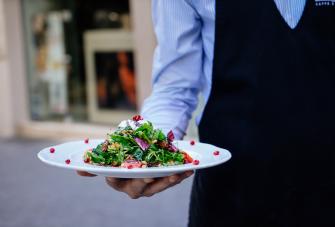How to Get More Tips When Working as a Server
Servers have a lot of responsibilities: they’re in charge of providing a great dining experience, ensuring their guests make the best choices for their meals, to name but a few. They’re also responsible for generating as many tips as possible. These tips can be shared with the rest of the restaurant or be used as the server’s sole source of income, depending on where in the world they work [1].
If you’re a server and want to earn a little extra money alongside your salary, here are some tips for getting more tips from your customers.
Recommend more expensive dishes
A tip is a gratuity given to the server at the end of the meal. The size of this gratuity is determined by the amount of the final bill. The tip is left to the customer to decide, but the average tip is anywhere between 10% and 20% of the bill’s total [2]. The larger the bill, the larger the tip.
Because the tip is calculated from the final amount, it behooves servers to gently encourage their customers to buy more expensive items. The higher the bill at the end, the more money they’re likely to get in their tip.
So, if you want a large tip, you’ll want to encourage your customers to buy as much as possible and to opt for the most expensive items on your menu.
Upsell with gusto
Upselling is a crucial part of being a server, and one of the best ways that they, and the restaurant, can make money.
Upselling, or suggestive selling, is when customers are encouraged to spend more than they had originally intended by suggesting they upgrade to a more expensive dish, or to buy extras, like desserts, extra sides, or alcohol.
Let’s say your customer chooses a bottle of wine for their meal. You, if you think it’s appropriate, may try to convince the customer to buy a more expensive wine that would pair very well with the food they ordered. Or, you might suggest an extra side to go with a dish they think would work very well.
You shouldn’t simply see upselling as a way to pile more items onto your customers’ final bill, though. Each suggestion you make should be appropriate to the person and the situation.
Connect with customers
When people go out to eat, they want to dine in an atmosphere that’s inviting, warm, and, above all, comfortable. Creating that atmosphere of comfort and ease is your responsibility as a server.
Do everything you can to make your customers feel welcome and at home. Build a sense of familiarity by using their names when you speak to them. Make small-talk about the weather or the traffic. Tell a joke here and there to lighten the mood. Build anticipation for the meal to come by describing your kitchen’s specials with flare.
When you make your guests feel welcome and comfortable, they’re more likely to be in a generous mood to give you those higher tips at the end of the meal.
Anticipate your customers’ needs
One of the most important aspects of serving is anticipating your customers’ needs and meeting them, ideally before they even have to ask.
There are many ways you can anticipate your customers’ needs. If you see a family with small children, you can approach a table with children’s menus ready at hand. Or, if you see that your guests are coming in from a cold night, you might recommend starting their dining experience with some warm drinks or heavy alcohol to make them more comfortable. Or, upon speaking to your customers, you might identify tastes and preferences that may inspire suggestions for particular menu items.
No matter how you do it, a customer who feels that they dined at an establishment that knew and met their needs may be more inclined to tip generously when the time comes.
Don’t be pushy
While it’s your role to upsell and push specials as and when your kitchen needs you to, you don’t want to be too forceful in your suggestions. If you’re too pushy in your suggestions, the customer may feel under pressure or manipulated. Keep things light and friendly, and if they decide to ignore your suggestion, take it in stride. It’s their meal, after all.
Cultivate reciprocity
People are more likely to do something good for you if you do something good for them. This is called reciprocity. It’s a deeply ingrained social and psychological practice that ensures humans share and collaborate to survive [3].
Customers who receive something, even if it’s something small or fairly insignificant, will often reciprocate with a generous tip.
Servers can cultivate reciprocity in several ways. They can give away free drinks and food if allowed, provide compliments to their customers on their food choices, or go out of their way to give especially good service. Doing these things is more likely to elicit a positive response from customers, which will likely lead to good tips.
Let’s look at an example. A server is bringing food to their customers’ table, but delays slightly. Upon the food’s arrival, she tells the customers that some of the plates were not up to her particular standards and that she got the kitchen to correct the mistake for them.
The customers, in turn, will feel as if they were getting special treatment, that a favour was done for them, and they will be more predisposed to giving out bigger tips to the server.
Take a course
One of the best ways to get more tips is to improve the general quality of the service you provide. To do this, you can take a course in food service, food service management, or some other area, like wine expertise or coffee service. Getting a certificate for sommelier knowledge [4] or barista practice [5] will give you the skills you need to impress your guests. These qualifications may also open doors for you at higher-end restaurants, where the bills, and tips, will be larger.
Master your POS system
There’s nothing worse than watching your server fumble with a card machine as you wait for your bill. Your customers’ meal should be a completely seamless process, and that includes preparing the bill. To maintain that atmosphere of seamless service, you need to master your restaurant’s POS system.
A restaurant’s POS system doesn’t just have to be a machine for tabulating prices and bills. It can be an inventory tracking system, a floor plan management tool, or a customer loyalty tracker. With the right POS system, you can do so much during your service that will help you streamline your operations. Doing this will help you make your operations more efficient, providing better service, and, as a result, be a magnet for huge tips.
With an Epos Now Restaurant POS system, you can:
- Track time-at-table and manage floor plans in real-time to boost table turnover
- Eliminate costly errors with automated ordering and effortless communication
- Streamline back of house operations with a comprehensive Kitchen Display System
- Group by course and order type to speed up preparation and reduce customer wait times
- Minimize floor traffic, eliminate physical receipts, and put an end to long lines at the till
- Inside, outside, or curbside: take orders from anywhere to speed up service
- Maximize upsell opportunities by freeing up your waiting staff to spend more time with guests
- Speed up service and increase covers with fast, hassle-free service
- Increase accuracy, and ensure that your customers get exactly what they want. On-time, every time
Contact Epos Now to find out more about our systems and services.




